Tefillin vs. hatred in University of Pennsylvania
(Video: Chabad University of Pennsylvania)
“Among the Jewish protesters supporting Gaza, some stopped by our stand to put on tefillin. This didn't stop them from continuing to chant ‘From the river to the sea, Palestine will be free,’ implying the takeover of all of Israel. They argue that Israel represents colonialism and won't rest until Israel is a ‘liberated’ state.
More stories:
On the other hand, one lit Shabbat candles and another responded to our call to put on tefillin. So, there's a Jewish spark in them. With a positive outlook, I can say that those more connected to Judaism generally support Israel. The souls of these young people are eager to put on tefillin and light Shabbat candles, because they are an inseparable part of the Jewish people, the people of Israel.
Chabad emissary at the University of Pennsylvania Rabbi Levi Yitzchak Hazaklevich found himself in a complicated situation: his regular tefillin stand was situated amid a pro-Palestinian rally. In a minute-long video filmed by the rebbetzin, the rabbi, wearing a black yarmulke and visible tzitzit, can be seen assisting a Jewish student on campus with the mitzvah of putting on tefillin, all while a protest in support of Gaza and the liberation of Palestine takes place nearby.
"This is one of the top universities in the world, on par with Yale, Princeton and Harvard. Overall, this university is not anti-Israel and there are many positive activities that take place here," says Rabbi Hazaklevich.
However, he adds, "On the Saturday before Yom Kippur, there was a festival of Palestinian journalists, among whom were outright antisemitic speakers and individuals with a history of ties to terrorists. The university, including faculty and donors, voiced their opposition to this. While there were criticisms, no one shut down the event as a form of protest."
When the march passed by you, were you concerned about the reactions?
“At the protest, some approached our table with a confrontational attitude. One even raised a hand against a student who was putting on tefillin, but the police intervened immediately and detained the young man, who was, of course, released shortly after.
“There were also those who made derogatory remarks. However, generally, the responses were more positive and encouraging, and we distributed close to 150 Shabbat candle kits.
"She shared that her grandparents were Holocaust survivors. I told her they probably didn't know what she was doing there, among the protestors, especially when she chanted 'from the river to the sea'. I asked her what she meant by that phrase, and she replied that it signifies Palestinians should have the same freedom as Israelis. I responded: 'That might be your interpretation, but it's not what they think.'"
“Regrettably, among the protestors were also Jews. One of them stepped out of the protest group, approached us, and put on tefillin with one of our students who is affiliated with Chabad. Yet, that didn't stop him from continuing to protest against Israel while supporting the residents of Gaza."
"Jewish female students passing by our booth stopped, asked for Shabbat candles, and some even wanted to give charity. One of the girls asked me for Shabbat candles. I suggested she light them in honor of the land of Israel, and she asked if she could light them for the people of Gaza instead. I told her to light them for the sake of innocent people everywhere, and we then talked for over half an hour on the topic.
"She shared that her grandparents were Holocaust survivors. I told her they probably didn't know what she was doing there, among the protestors, especially when she chanted 'from the river to the sea'. I asked her what she meant by that phrase, and she replied that it signifies Palestinians should have the same freedom as Israelis. I responded: 'That might be your interpretation, but it's not what they think. That phrase means they intend to drive all Jews into the sea, and even more than that.' We spoke for over half an hour. When she left, we didn't agree, but I pray that maybe something resonated with her.
"Look, people simply don't feel comfortable with this complicated situation, and they are concerned. Therefore, despite the worries my wife and I had, even though I appeared calm in the video, it was crucial for us to go to the campus and show our presence during the protest. We felt it was essential to provide Jewish students coming out of their classes an opportunity to pray, put on tefillin, and feel at ease. In the end, this is what needs to be done, especially in these challenging times of conflict: to demonstrate strength."
Nechama, who has been by his side throughout their journey, adds her perspective on the moment that led her to film the viral video. "It was a very challenging moment, and I know that using the word 'difficult' at times when Israel is suffering so much might seem like an understatement. The current situation on U.S. campuses is such that Jewish students feel intimidated, insecure and highly uncomfortable. For us, it's a vital mission to be here for them."
What were the reactions to the video?
"I received many calls from people who saw it. It indeed awakened many and gave them a sense of Jewish pride. Some said it gave them much-needed courage, especially in these times when antisemitism is more rampant than ever."






